Analysis and Prediction of Electrospun Nanofiber Diameter Based on Artificial Neural Network
Abstract
:1. Introduction
2. Experimental Section
2.1. Materials and Reagents
2.2. Fabrication of PAN Electrospinning Solution
2.3. Fabrication of PAN Nanofiber
2.4. Characterization of PAN Nanofiber
2.5. Experimental Data Set
2.6. Training of the Artificial Neural Network
3. Result and Discussion
3.1. Morphology Characterization of Electrospun PAN Fiber
3.2. Analysis of the Artificial Neural Network Model
3.3. Interactions among Electrospinning Process Parameters
4. Conclusions
Supplementary Materials
Author Contributions
Funding
Institutional Review Board Statement
Informed Consent Statement
Data Availability Statement
Acknowledgments
Conflicts of Interest
References
- Zhang, M.X.; Song, W.L.; Tang, Y.X.; Xu, X.Z.; Huang, Y.N.; Yu, D.G. Polymer-Based Nanofiber-Nanoparticle Hybrids and Their Medical Applications. Polymers 2022, 14, 351. [Google Scholar] [CrossRef]
- Liu, H.R.; Jiang, W.L.; Yang, Z.L.; Chen, X.R.; Yu, D.G.; Shao, J. Hybrid Films Prepared from a Combination of Electrospinning and Casting for Offering a Dual-Phase Drug Release. Polymers 2022, 14, 2132. [Google Scholar] [CrossRef]
- Tian, J.M.; Shen, Z.H.; Cheng, H.T.; Jin, X.; Li, Z.H.; Wen, Y.; Hui, J.F.; Guo, S.H.; Zhang, H.G.; Zhu, Q.S. In-depth understanding of catalytic and adsorbing effects in polysulfides conversion and rationally designing coaxial nanofibers for Li-S batteries. Chem. Eng. J. 2023, 235, 207–214. [Google Scholar] [CrossRef]
- Shi, S.; Si, Y.F.; Han, Y.T.; Wu, T.; Iqbal, M.I.; Fei, B.; Li, R.K.Y.; Hu, J.L.; Qu, J.P. Recent Progress in Protective Membranes Fabricated via Electrospinning: Advanced Materials, Biomimetic Structures, and Functional Applications. Adv. Mater. 2022, 34, 2107938. [Google Scholar] [CrossRef]
- Xu, X.Z.; Zhang, M.X.; Lv, H.; Zhou, Y.J.; Yang, Y.Y.; Yu, D.G. Electrospun polyacrylonitrile-based lace nanostructures and their Cu (II) adsorption. Sep. Purif. Technol. 2022, 288, 120643. [Google Scholar] [CrossRef]
- Al-Abduljabbar, A.; Farooq, I. Electrospun Polymer Nanofibers: Processing, Properties, and Applications. Polymers 2023, 15, 65. [Google Scholar] [CrossRef]
- Zhu, F.; Zheng, Y.M.; Zhang, B.G.; Dai, Y.R. A critical review on the electrospun nanofibrous membranes for the adsorption of heavy metals in water treatment. J. Hazard. Mater. 2021, 401, 123608. [Google Scholar] [CrossRef]
- Chang, W.M.; Wang, C.C.; Chen, C.Y. The combination of electrospinning and forcespinning: Effects on a viscoelastic jet and a single nanofiber. Chem. Eng. J. 2014, 244, 540–551. [Google Scholar] [CrossRef]
- Yu, S.; Milam-Guerrero, J.; Tai, Y.Y.; Yang, S.; Choi, Y.Y.; Nam, J.; Myung, N.V. Maximizing Polyacrylonitrile Nanofiber Piezoelectric Properties through the Optimization of Electrospinning and Post-thermal Treatment Processes. ACS Appl. Polym. Mater. 2022, 4, 635–644. [Google Scholar] [CrossRef]
- Papkov, D.; Delpouve, N.; Delbreilh, L.; Araujo, S.; Stockdale, T.; Mamedov, S.; Maleckis, K.; Zou, Y.; Andalib, M.N.; Dargent, E.; et al. Quantifying Polymer Chain Orientation in Strong and Tough Nanofibers with Low Crystallinity: Toward Next Generation Nanostructured Superfibers. ACS Nano 2019, 13, 4893–4927. [Google Scholar] [CrossRef]
- Wang, T.; Kumar, S. Electrospinning of polyacrylonitrile nanofibers. J. Appl. Polym. Sci. 2016, 102, 1023–1029. [Google Scholar] [CrossRef]
- Kirecci, A.; Özkoç, Ü.; İçoğlu, H.İ. Determination of optimal production parameters for polyacrylonitrile nanofibers. J. Appl. Polym. Sci. 2012, 124, 4961–4968. [Google Scholar] [CrossRef]
- Almeida, D.S.; Duarte, E.H.; Hashimoto, E.M.; Turbiani, F.R.B.; Muniz, E.C.; Souza, P.R.S.; Gimenes, M.L.; Martins, L.D. Development and characterization of electrospun cellulose acetate nanofibers modified by cationic surfactant. Polym. Test. 2020, 81, 106206. [Google Scholar] [CrossRef]
- Choi, S.Y.; Han, E.M.; Park, K.H. Porosity Control of Electrospun PAN/PMMA Nanofiber Webs. Mol. Cryst. Liq. Cryst. 2019, 688, 68–74. [Google Scholar] [CrossRef]
- Vinh, N.D.; Kim, H.M. Electrospinning Fabrication and Performance Evaluation of Polyacrylonitrile Nanofiber for Air Filter Applications. Appl. Sci. 2016, 6, 235. [Google Scholar] [CrossRef] [Green Version]
- Du, J.; Shintay, S.; Zhang, X.W. Diameter control of electrospun polyacrylonitrile/iron acetylacetonate ultrafine nanofibers. J. Polym. Sci. Part B Polym. Phys. 2008, 46, 1611–1618. [Google Scholar] [CrossRef]
- Samadian, H.; Zakariaee, S.S.; Majidi, R.F. Evaluation of effective needleless electrospinning parameters controlling polyacrylonitrile nanofibers diameter via modeling artificial neural networks. J. Text. Inst. 2019, 110, 477–486. [Google Scholar] [CrossRef]
- Premasudha, M.; Reddy, S.R.B.; Lee, Y.J.; Panigrahi, B.B.; Cho, K.K.; Gari, S.R.N. Using artificial neural networks to model and interpretelectrospun polysaccharide (Hylon VII starch) nanofiber diameter. J. Appl. Polym. Sci. 2021, 138, 50014. [Google Scholar] [CrossRef]
- Reddy, B.S.; In, K.H.; Panigrahi, B.B.; Paturi, U.M.R.; Cho, K.K.; Reddy, N.S. Modeling tensile strength and suture retention of polycaprolactone electrospun nanofibrous scaffolds by artificial neural networks. Mater. Today Commun. 2021, 26, 102115. [Google Scholar] [CrossRef]
- Santos, A.F.; Aguado, R.; Corazza, M.L.; Tarrés, Q.; Salvador, J.L.S.; Blanco, A.; Negro, C.; Aguilar, M.D. Artificial neural network for aspect ratio prediction of lignocellulosic micro/nanofibers. Cellulose 2022, 29, 5609–5622. [Google Scholar] [CrossRef]
- Wang, F.J.; Elbadawi, M.; Tsilova, S.L.; Gaisford, S.; Basit, A.W.; Parhizkar, M. Machine learning to empower electrohydrodynamic processing. Mater. Sci. Eng. C 2022, 132, 112553. [Google Scholar] [CrossRef] [PubMed]
- Abdelhady, S.S.; Atta, M.; Megahed, A.; Hasel, K.A.; Alquraish, M.; Ali, A.A.; Zoalfakar, S.H. Modeling electrospun PLGA nanofibers’ diameter using response surface methodology and artificial neural networks. J. Ind. Text. 2022, 52, 1–23. [Google Scholar] [CrossRef]
- Khatti, T.; Manesh, H.N.; Kalantar, S.M. Prediction of diameter in blended nanofibers of polycaprolactone-gelatin using ANN and RSM. Fibers Polym. 2017, 18, 2368–2378. [Google Scholar] [CrossRef]
- Narayana, P.L.; Wang, X.S.; Yeom, J.T.; Maurya, A.K.; Bang, W.S.; Srikanth, O.; Reddy, M.H.; Hong, J.K.; Reddy, N.G.S. Correlating the 3D melt electrospun polycaprolactone fiber diameter and process parameters using neural networks. J. Appl. Polym. Sci. 2021, 138, 50956. [Google Scholar] [CrossRef]
- Rubio, J.D.J. Stability Analysis of the Modified Levenberg-Marquardt Algorithm for the Artificial Neural Network Training. IEEE Trans. Neural Netw. Learn. Syst. 2021, 32, 3510–3524. [Google Scholar] [CrossRef] [PubMed]
- Ahmad, T.; Chen, H.X. A review on machine learning forecasting growth trends and their real-time applications in different energy systems. Sustain. Cities Soc. 2020, 54, 102010. [Google Scholar] [CrossRef]
- Sherwani, F.; Ibrahim, B.S.K.K.; Asad, M.M. Hybridized classification algorithms for data classification applications: A review. Egypt. Inform. J. 2021, 22, 185–192. [Google Scholar] [CrossRef]
- Armaghani, D.J.; Mirzaei, F.; Shariati, M.; Trung, N.T.; Shariati, M.; Trnavac, D. Hybrid ANN-based techniques in predicting cohesion of sandy-soil combined with fiber. Geomech. Eng. 2020, 20, 191–205. [Google Scholar]
- Armaghani, D.J.; Asteris, P.G. A comparative study of ANN and ANFIS models for the prediction of cement-based mortar materials compressive strength. Neural Comput. Appl. 2021, 33, 4501–4532. [Google Scholar] [CrossRef]
- Malayeri, M.; Nasiri, F.; Haghighat, F.; Lee, C.S. Optimization of photocatalytic oxidation reactor for air purifier design: Application of artificial neural network and genetic algorithm. Chem. Eng. J. 2023, 462, 142186. [Google Scholar] [CrossRef]
- Zhao, S.L.; Wu, X.H.; Wang, L.G.; Huang, Y. Electrospinning of Ethyl yanoethyl Cellulose/Tetrahydrofuran solutions. J. Appl. Polym. Sci. 2004, 91, 242–246. [Google Scholar] [CrossRef]
- Ki, C.S.; Baek, D.H.; Gang, K.D.; Lee, K.H.; Um, I.C.; Park, Y.H. Characterization of gelatin nanofiber prepared from gelatin–formic acid solution. Polymer 2005, 46, 5094–5102. [Google Scholar] [CrossRef]
- Jiang, H.L.; Zhao, P.C.; Zhu, K.J. Fabrication and Characterization of Zein-Based Nanofibrous Scaffolds by an Electrospinning Method. Macromol. Biosci. 2007, 7, 517–525. [Google Scholar] [CrossRef] [PubMed]
- Demir, M.M.; Yilgor, I.; Yilgor, E.; Erman, B. Electrospinning of polyurethane fibers. Polymer 2002, 43, 3303–3309. [Google Scholar] [CrossRef]

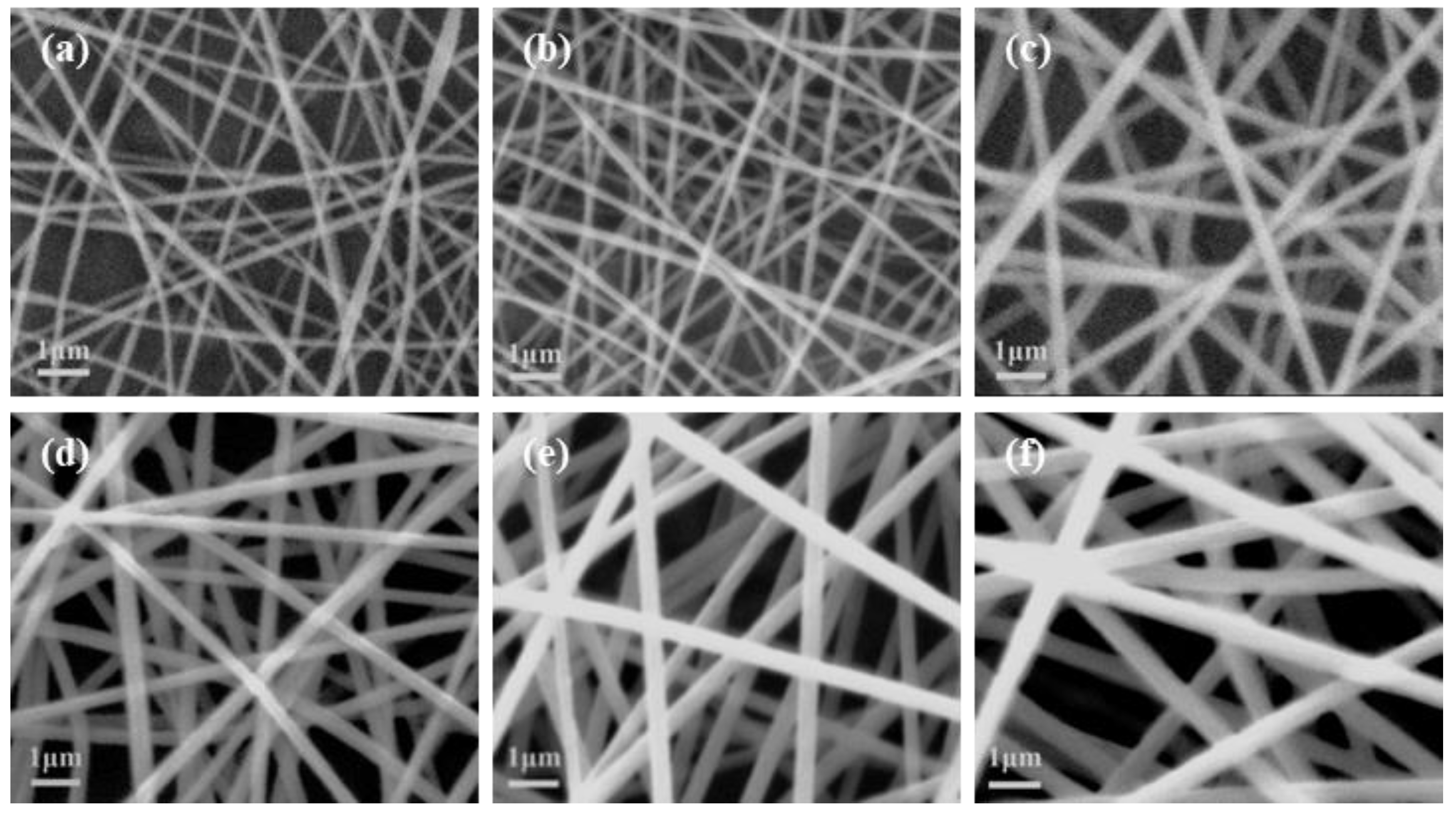
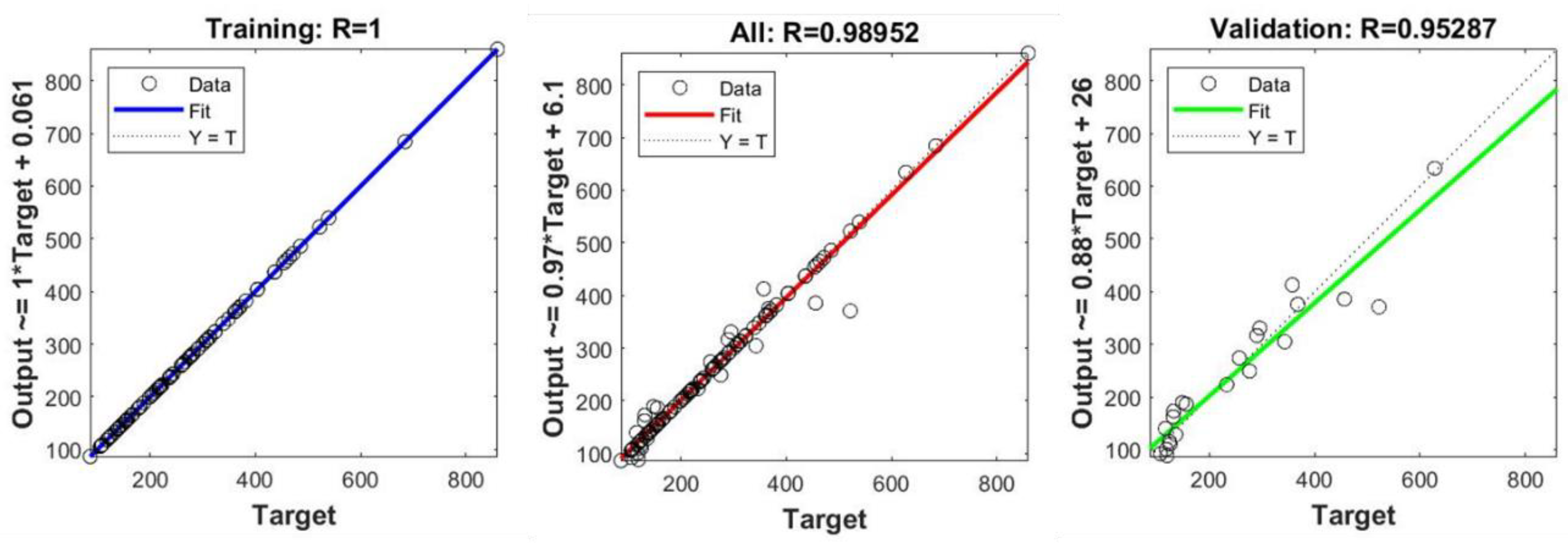
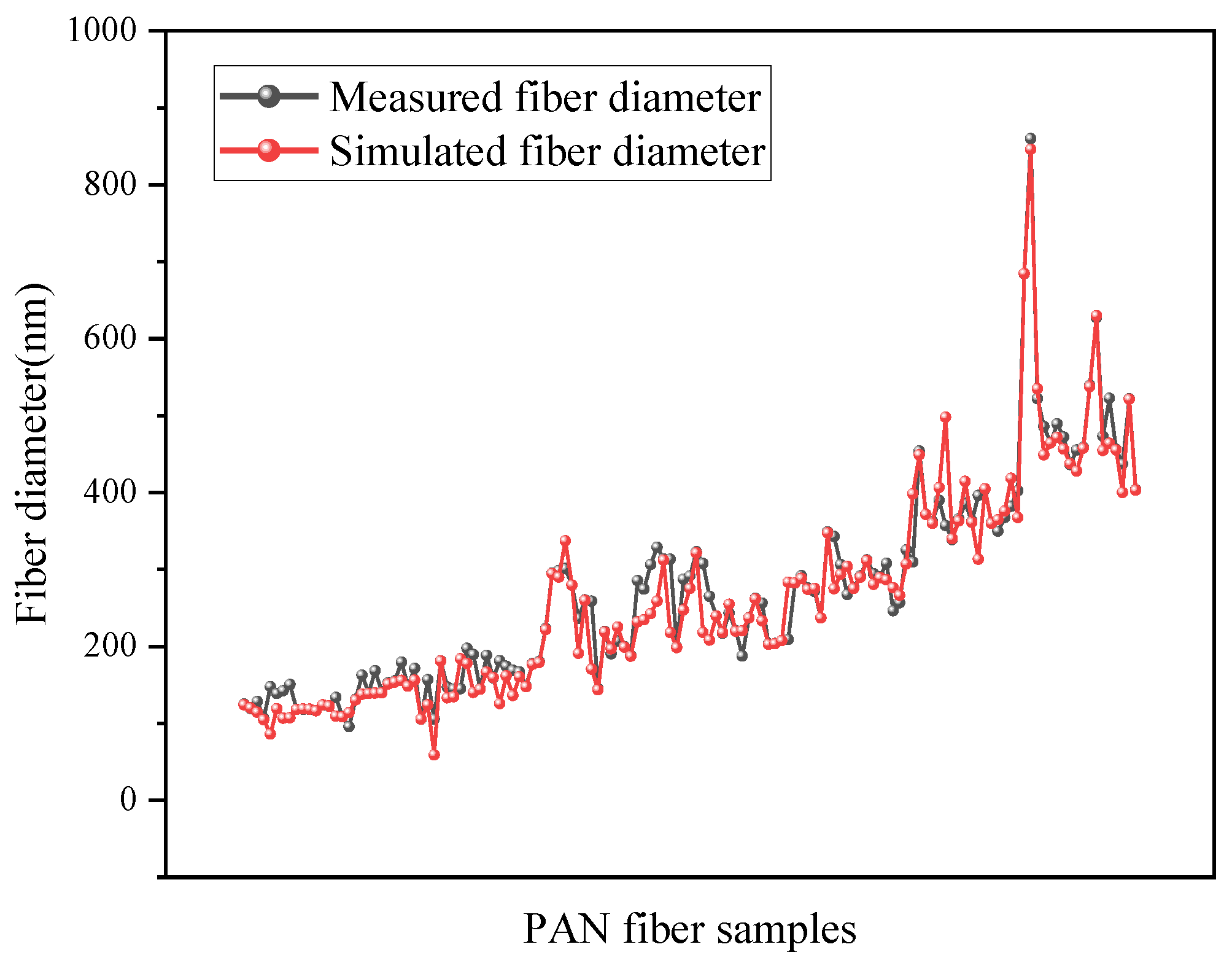
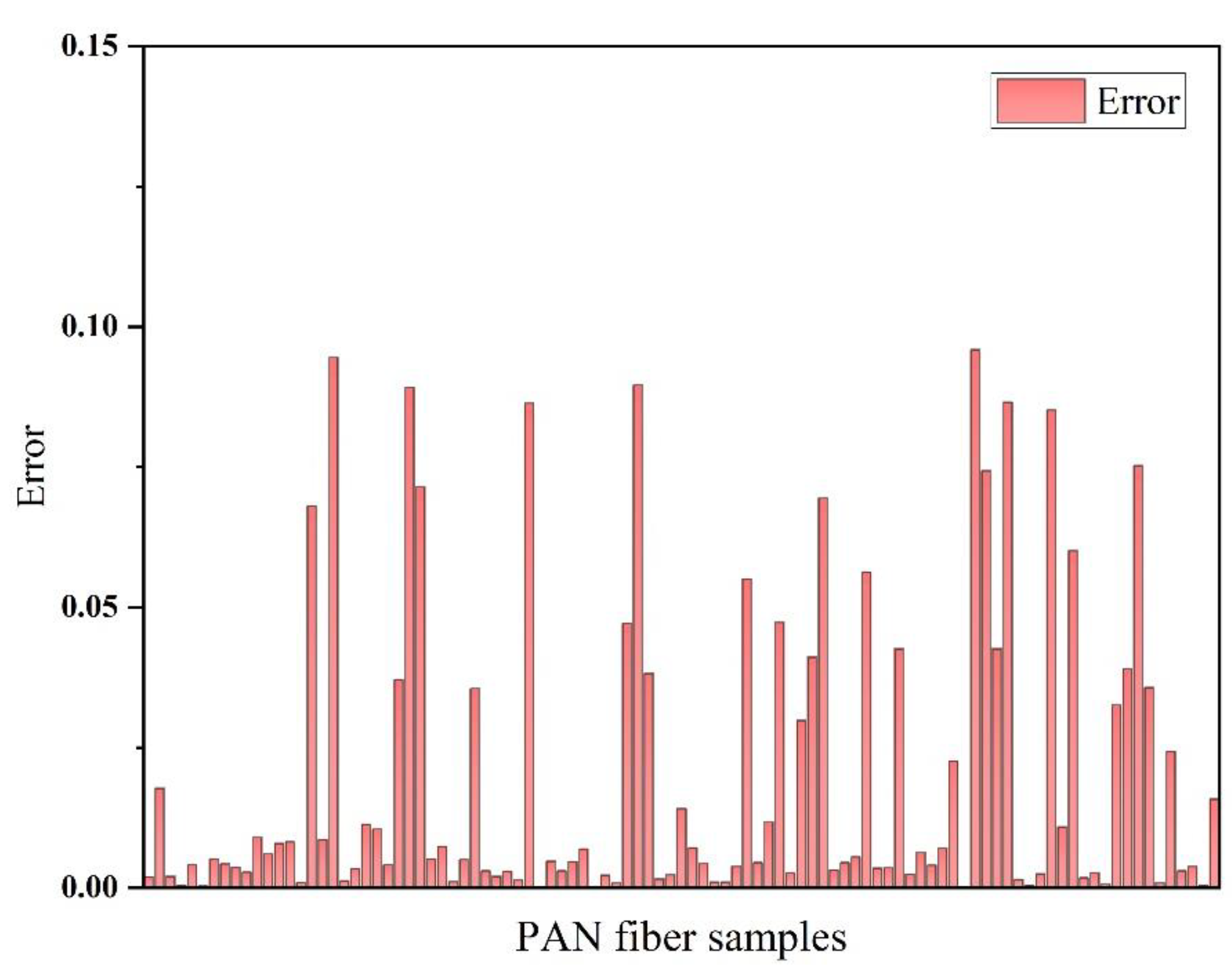
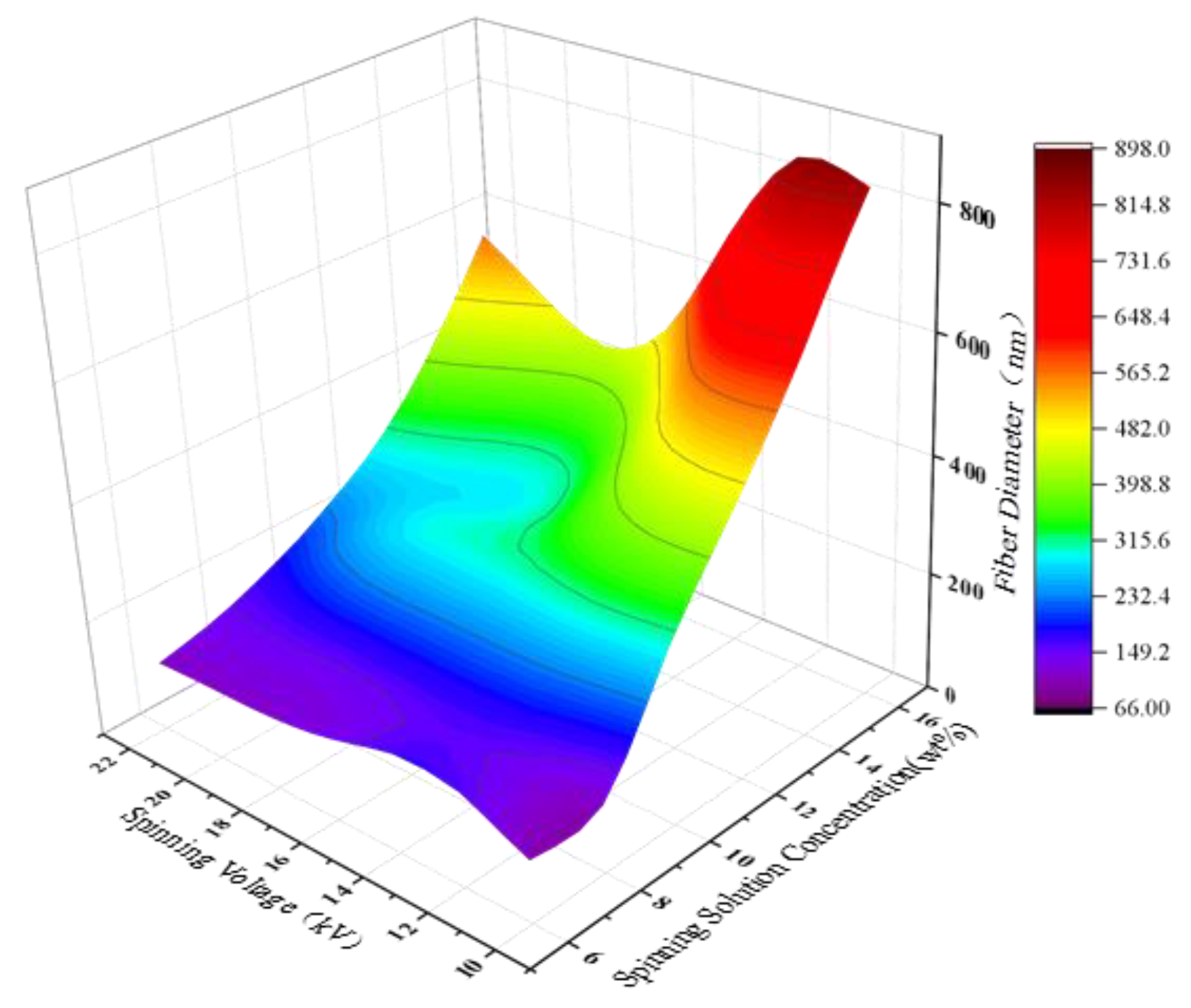

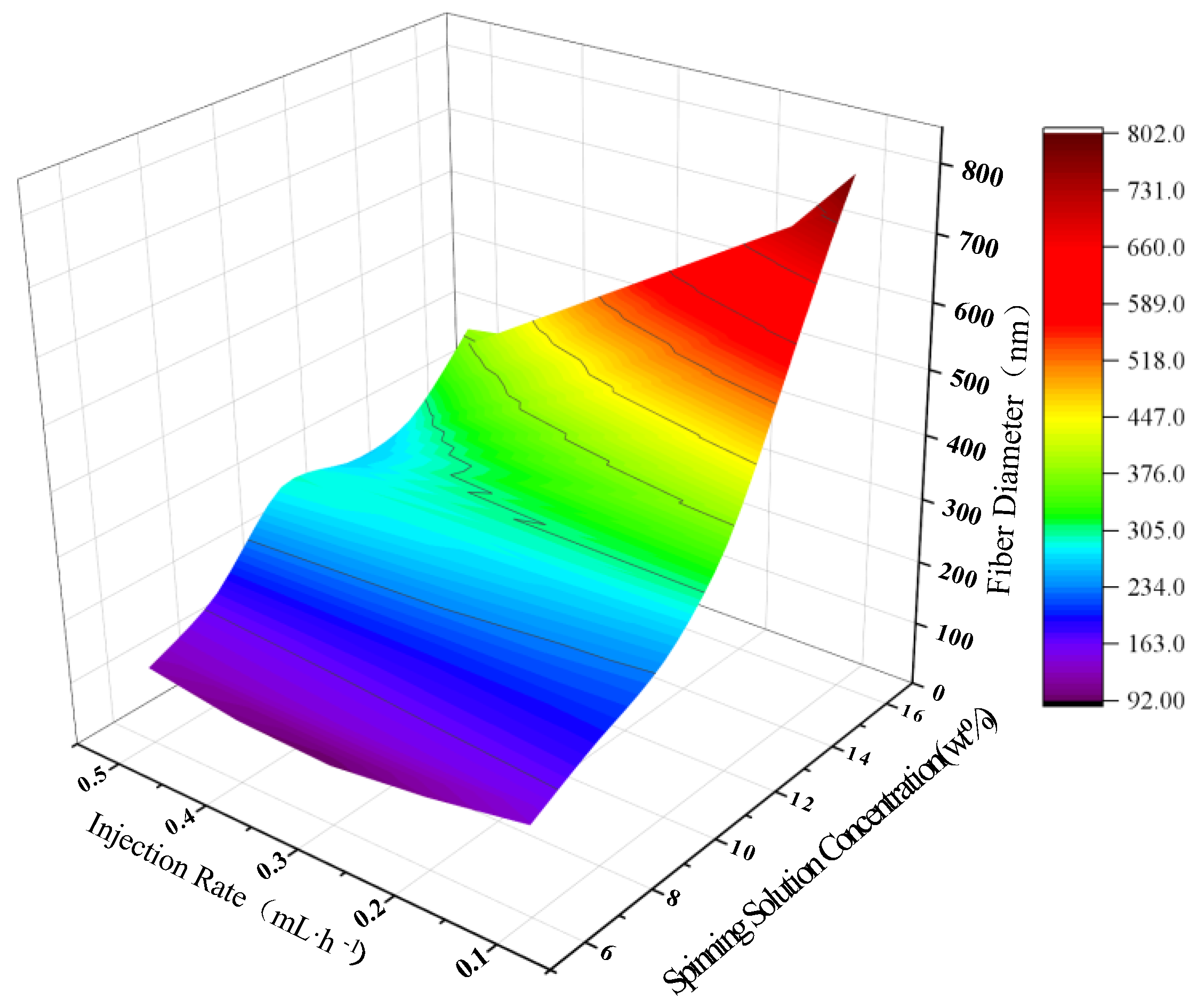
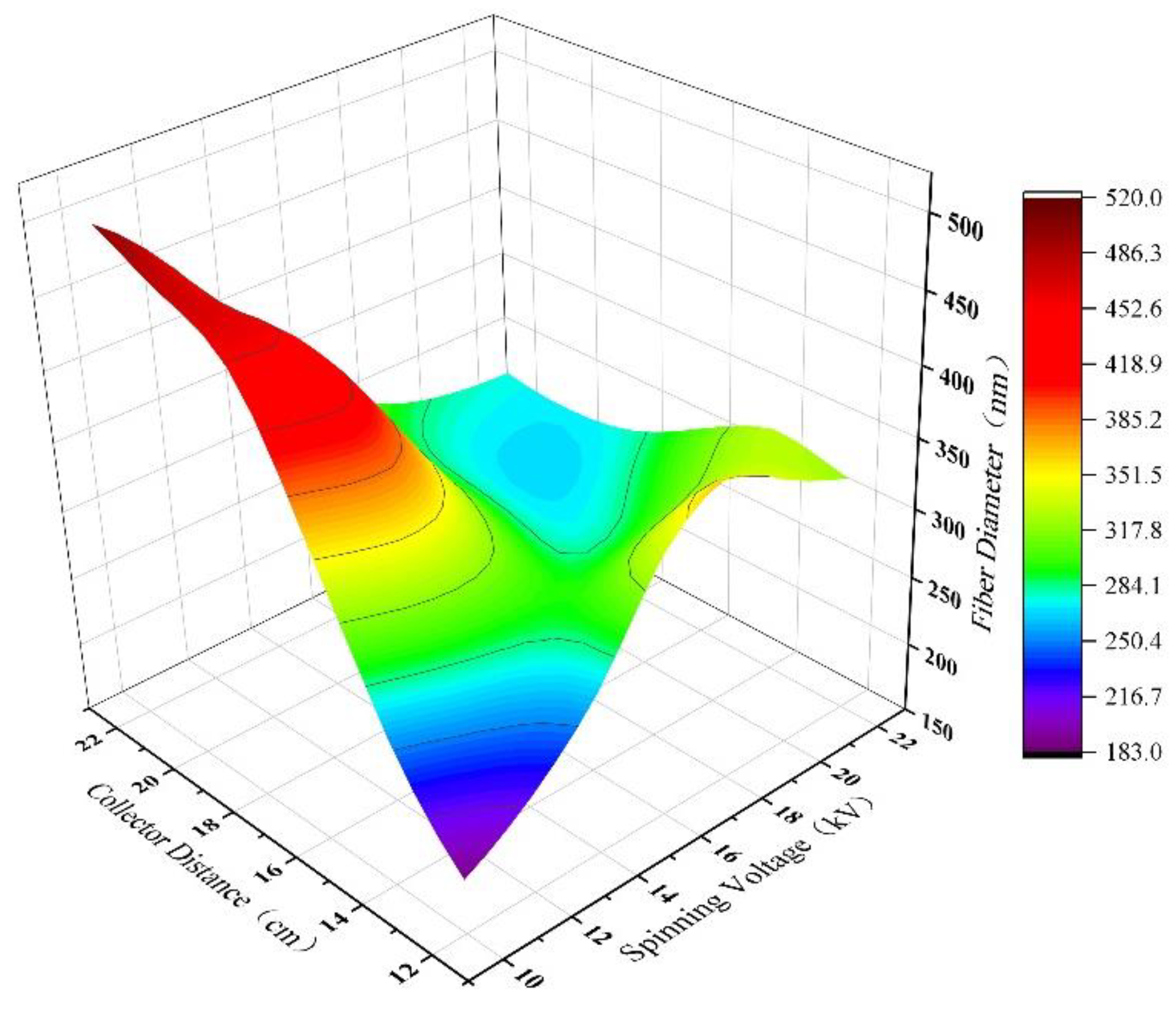
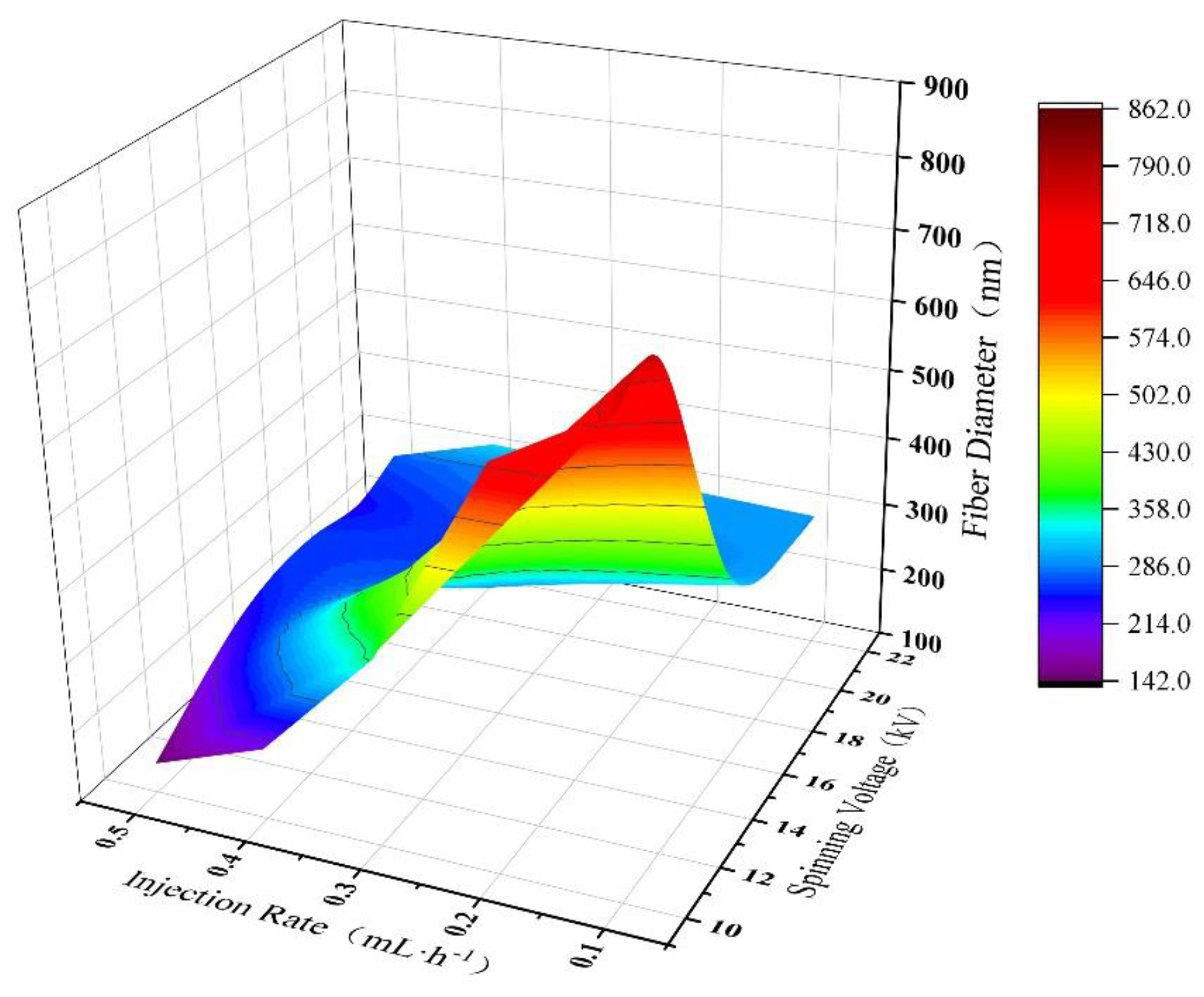
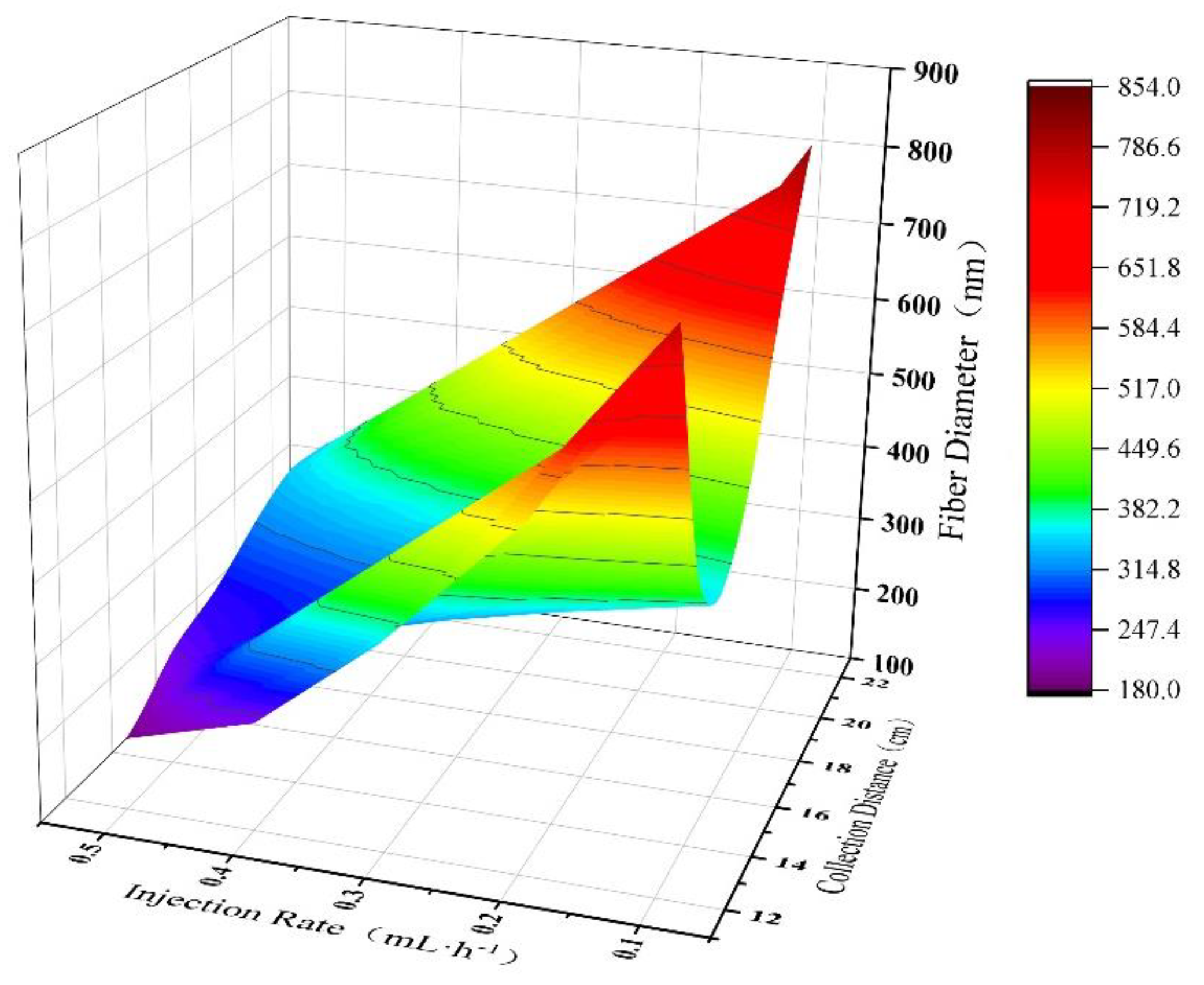
| Exp. No. | Concentration (wt%) | Voltage (kV) | Receiving Distance (cm) | Injection Speed (mL/h) | Measured Diameter (nm) | Simulated Diameter (nm) | Error |
|---|---|---|---|---|---|---|---|
| 1 | 10 | 15 | 12 | 0.3 | 279.95 | 280.43 | 0.17% |
| 2 | 10 | 15 | 12 | 0.4 | 295.02 | 299.22 | 1.42% |
| 3 | 10 | 15 | 14 | 0.5 | 195.9 | 193.95 | 0.99% |
| 4 | 10 | 15 | 16 | 0.3 | 200.28 | 202.26 | 0.99% |
| 5 | 10 | 15 | 16 | 0.4 | 212.24 | 213.96 | 0.81% |
| 6 | 10 | 15 | 18 | 0.2 | 173.99 | 173.41 | 0.33% |
| 7 | 10 | 15 | 18 | 0.5 | 213.19 | 208.61 | 2.15% |
| 8 | 10 | 15 | 20 | 0.2 | 235.15 | 237.61 | 1.05% |
| 9 | 10 | 15 | 20 | 0.3 | 307.22 | 308.04 | 0.27% |
| 10 | 10 | 15 | 20 | 0.5 | 165.93 | 169.51 | 2.16% |
Disclaimer/Publisher’s Note: The statements, opinions and data contained in all publications are solely those of the individual author(s) and contributor(s) and not of MDPI and/or the editor(s). MDPI and/or the editor(s) disclaim responsibility for any injury to people or property resulting from any ideas, methods, instructions or products referred to in the content. |
© 2023 by the authors. Licensee MDPI, Basel, Switzerland. This article is an open access article distributed under the terms and conditions of the Creative Commons Attribution (CC BY) license (https://creativecommons.org/licenses/by/4.0/).
Share and Cite
Ma, M.; Zhou, H.; Gao, S.; Li, N.; Guo, W.; Dai, Z. Analysis and Prediction of Electrospun Nanofiber Diameter Based on Artificial Neural Network. Polymers 2023, 15, 2813. https://doi.org/10.3390/polym15132813
Ma M, Zhou H, Gao S, Li N, Guo W, Dai Z. Analysis and Prediction of Electrospun Nanofiber Diameter Based on Artificial Neural Network. Polymers. 2023; 15(13):2813. https://doi.org/10.3390/polym15132813
Chicago/Turabian StyleMa, Ming, Huchen Zhou, Suhan Gao, Nan Li, Wenjuan Guo, and Zhao Dai. 2023. "Analysis and Prediction of Electrospun Nanofiber Diameter Based on Artificial Neural Network" Polymers 15, no. 13: 2813. https://doi.org/10.3390/polym15132813






